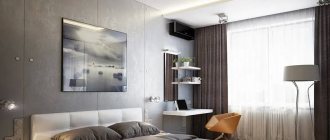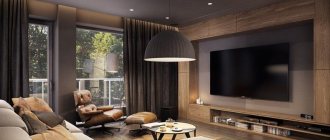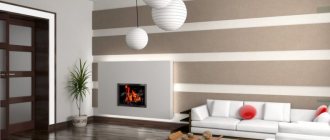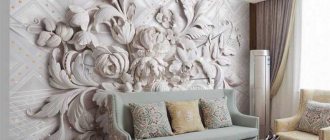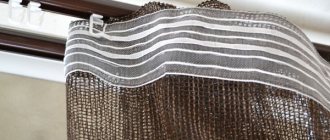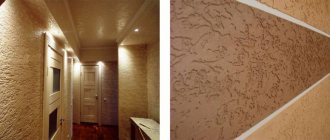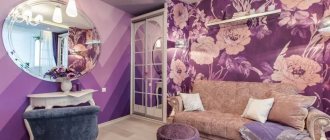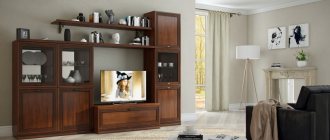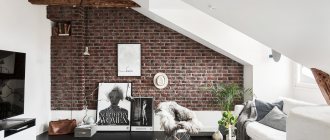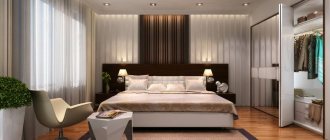Decorating walls with stone is an original way to decorate an apartment. Use it in combination with wallpaper or paint for an original effect. Read our article to learn how to choose a stone for your wall. We will advise which layout styles are best suited for this type of finish.
What will you read about in the article?
- Decorating walls with stone - pros and cons
- Stone walls of the hall - what material to choose?
- Stone on the wall in the living room - what to use?
- Which stone to choose for the wall in the kitchen?
- Is rock on the bathroom wall a good idea?
- Plaster and concrete stone for the wall - is it worth it?
Wall finishing technology
Before installation, you will need to go through a series of steps and carry out preparatory work:
- The wall must be cleaned of grease and dust, old finishes;
- Think in advance about the placement of utilities and electrical structures;
- The plane of the wall should be leveled if the curvature exceeds 0.2 mm/m. An exception can be made only for the rough texture of the building material;
- Existing cracks should be repaired with plaster, and then a layer of leveling putty should be applied. If necessary, it is possible to use a reinforcement method. The best option for leveling would be to cover the walls with plasterboard sheets;
- When the wall is sufficiently smooth, it needs to be treated with a suitable primer;
- To speed up installation and accurately determine the number of products, it is recommended to draw a sketch of the finished cladding on the prepared wall. Or, using the puzzle method, lay out decorative samples on the floor;
Example of installation in the kitchen
An adhesive binder is used to attach the tiles to the walls. If the solution is prepared correctly, it will fix the imitation image for many years. The glue recipe looks simple: a special powder is combined in the required proportions (indicated on the package) with water, and then beaten with a mixer. The finished solution is capable of fixing even bulky stones. For small products it is possible to use liquid nails or budget sand-cement mortar.
Stone panel, stylish and rich
Natural stone in the interior - advantages of decorating
The art of design has created a huge number of options for using stone in the interior, both natural and artificial.
A good imagination will help you imagine and bring to life many variations of cladding that will decorate any home.
The use of natural stone has the following advantages:
- unique texture pattern;
- naturalness;
- good soundproofing qualities;
- a wide range of colors, textures and prices;
- long service life, easy to use.
The following varieties are widely used in decoration:
- brick;
- limestone and sandstone rocks;
- slate;
- coral stones.
Photo gallery - even more ideas
In the photo selection below you will see how else you can use decorative stone in the interior. The gallery of images includes the most interesting design solutions for finishing stairs, niches and arches.
Sources
- https://m-strana.ru/design/sposoby-ispolzovaniya-dekorativnogo-kamnya-v-interere/
- https://ReHouz.info/dekorativnyj-kamen-v-interere-foto/
- https://www.InMyRoom.ru/posts/16103-dekorativnyj-kamen-v-interere-s-foto
- https://www.dizainvfoto.ru/dekor/dekorativnyj-kamen-v-interere-vse-sekrety-izyskannoj-otdelki.html
- https://design-homes.ru/idei-dlya-doma/ispolzovanie-kamnya-v-interere-kvartiry-vidy-sochetaniya-65-foto
- https://stroyday.ru/remont-kvartiry/steny-i-potolok/iskusstvennyj-kamen-v-interere.html
- https://ars.ru/vnutrennyaya-otdelka-pod-kamen-v-raznyh-komnatah/
- https://J.Etagi.com/ps/otdelka-dekorativnym-kamnem/
- https://www.ivd.ru/dizajn-i-dekor/dekorirovanie/7-tipov-iskusstvennogo-i-naturalnogo-kamnya-i-nyuansy-ih-ispolzovaniya-v-interere-35451
- https://Trizio.ru/dekorativniy-kamen-v-interere-foto-20
Decorative stone in the living room: secrets of application
The use of stone in the interior of the living room allows you to achieve a feeling of calm and comfort. The owners of such a living room note some protection, which is achieved through a combination of two elements - fire and stone. The best example to prove this statement is a stone hearth, which is associated exclusively with comfort and warmth in the house. Undoubtedly, for a small apartment such decoration becomes inappropriate, since visually the stone will clutter the space, narrowing it. Therefore, it is recommended to use the stone in a spacious living room, which can be in a large house or cottage.
Decorative stone has several distinctive features compared to artificial stone. Natural stone has a wide variety of colors. But it also requires painstakingness and a serious approach to its use. In addition, natural stone requires special processing using modern techniques, which allows the material to be as close to natural quality as possible. All this makes artificial stones more popular compared to natural stone.
What textures are used in cladding?
Artificial or decorative stone in the interior of an apartment is:
- fashionable;
- exquisite;
- aristocratic;
- extravagantly;
- luxuriously;
- creative.
The most luxurious look is white stone in the interior or covered with enamel. It does not destroy the special atmosphere of the bedroom and perfectly sets off other finishing materials and textiles. It fits perfectly into most styles, regardless of texture. The best solution for a modern bedroom is with imitation white marble on top of a “warm floor” system. The wall cladding behind the head of the bed can be of any texture and not necessarily white.
For design purposes, sometimes a rough texture or contrasting finish is needed. This is used in urban and technological styles - loft, hi-tech or techno. Upholstered furniture of unusual shape requires a corresponding wall or panel. A spectacular backdrop behind a sofa or armchairs, lined with stone decor in a living room or large recreation area, looks very stylish.
Typically, decorative stone is used in hallways and corridors
The fireplace looks elegant against the background of a stone wall
Some people like it when decorating a living space with stone brings a special “wild” atmosphere. The room is more reminiscent of a deserted beach near a cliff, a stone grotto in the mountains, or a cave inhabited by modern city dwellers. In this case, a material with a texture close to the natural surface is used.
Photo wallpaper with a 3D effect, roughly processed wood and vertical landscaping - a wall with living plants - will give a special impression to the “wild nature” corner. Artificial stone in such an interior should imitate natural analogues as much as possible, the masonry should be uneven and a little chaotic. This is exactly what an eco-style room should look like - photo.
Decorating an apartment often involves the use of smooth polished pebbles (river or sea) or colored sea pebbles. An excellent way to use it is to lay out a mosaic pattern, and then paint some fragments. An excellent solution is to lay out pebbles on a kitchen splashback or a decorative panel in a living room.
Finishing the walls with decorative stone would be the right decision.
The wall decoration in the living room is made of decorative gray stone
Decorative stone in the living room will look chic
The use of rough textures has no restrictions for people with imagination and a creative approach to business. But sometimes this goes beyond reason, and luxurious decoration can look gloomy and uninviting for various reasons:
- too small room, narrow walls;
- the proportional limit of the stone texture of the floor and walls has been exceeded;
- different types of cladding are poorly arranged;
- The cladding does not match the style.
Designers prefer this type of room decoration for the special atmosphere of stone. Other materials do not have such a magical aura. But it should not be used as the main material, only as a spectacular decor.
Decorative stone is very durable and perfectly complements the design of the room
The right decision would be to decorate the walls in the kitchen with decorative stone
How to choose wall decor in the living room?
First of all, look at the wall you are going to fill. This is necessary to determine the size and format of photographs or paintings. To choose the ideal size, you should measure the dimensions of the empty wall and subtract 30-60 centimeters on each side. Otherwise the picture will look too massive.
Design tips
1. It is optimal if the painting is located in the center of the wall, but has a distance to the edge of the wall of about 15-30 centimeters on each side (as in the photo below). For example, the width of your wall is 90 centimeters. The picture will look good if you leave at least 15 centimeters to the edge. The maximum width of the canvas in this case should be about 60 centimeters. A painting that is too small will be visually “lost,” especially if you have massive furniture.
2. Choose wall decor that is the same length or slightly shorter than the furniture that is underneath it. This applies to cases when the painting is located above a sofa, bed, table or cabinet. You should not decorate the wall with canvases that are wider than the furniture - it looks ridiculous.
3. What if you have a huge wall? Small square photographs or paintings are a great option for decorating a large or non-standard wall. Large paintings are expensive, they are inconvenient to bring into the apartment and hang
Better pay attention to small canvases that can be placed as a collage. This is very relevant for modern living rooms
4. Use modular paintings. Hang the painting in a diptych or triptych, which are two, three or more parts of a painting flowing into one another. Be sure to leave at least 5 centimeters between pieces. You can make larger intervals if you have a very large wall - the main thing is that it looks harmonious. There are also large format canvases and photo wallpapers that can be used to set the mood in your living room.
Decorating room surfaces
- Walls
Walls with masonry are stylish and even strict. Who would have thought that stone could bring warmth, comfort and a finished look to the entire space. The first thing you need to do is choose the material itself: brick, cobblestone, river stone. It is also necessary to decide on the size: solid layers or small elements, what exactly will be displayed on the wall. There are many advantages to this decor: walls decorated with stone elements create additional insulation. And this is important, especially in the conditions of standard apartments. Such a wall seems to emerge from nature or a fairy tale, diluting the modern interior. It is necessary to think about proper lighting.
- Floor
Stone flooring has been popular for a long time. There is a wide range of finishing options. But there are also limitations: some types of material are quite fragile, they can easily be damaged by something sharp or careless movement. It will be completely unsafe to walk on it. An interesting option will turn out if you use pebbles in the shower, bathroom, or hallway. In the kitchen, such a covering will be very convenient.
- Fireplace
A fireplace trimmed with stone looks chic and elegant. A fireplace will create a cozy and fabulous atmosphere around you, where friends and family will want to gather. For many centuries in a row, finishing was done with brick. Its fire resistance ensured its popularity. Today, other materials are used, their properties are similar to the thermal properties of brick: tiles made of baked clay, porcelain stoneware, natural or artificial stone. All these finishing materials can withstand high temperatures and protect against the penetration of moisture and soot.
- Ladder
Another option that designers borrowed from the Middle Ages. The stone steps look as close to nature as possible. They are durable and will last for many years. This finish is used mainly in large houses and cottages. There is an option to use partial masonry, laying masonry over wooden layers. You can also use artificial stone. This will reduce costs
- Doors, arches, niches
Many interior elements can be decorated with stonework. The stone on both sides of the door will emphasize the informal atmosphere and style of the room, and will also draw attention to the canvas itself. Arches are often decorated with stone. In an ordinary interior, such an arch will focus attention and give a special charm to the room. A niche lined with stone can also serve as a decorative element. On its background you can place flowers, panels, paintings, TV. And all this will fit well into any interior style.
Types of decorative stone
Decorative stone is in demand due to the variety of colors and textures that imitate one or another type of natural material. When choosing a color, you need to consider that it should match the main background or create a reasonable contrast with the adjacent decoration.
Materials
Artificial stone, no matter how strange it may sound, is produced on the basis of various natural materials, of which the main ones are the following:
— Agglomerate of quartzite, granite and marble - the composition is obtained by crushing stones into small chips, which are then combined with cement and binding resins. Some types contain coloring pigments. The result is a glossy finish interspersed with natural fragments;
— Cement is the most durable, but at the same time, heavy material, so before cladding, high-quality strengthening of the walls is required. It has a long service life and is also suitable for external cladding of buildings;
— Gypsum, unlike cement, is a fairly lightweight material that has a lower cost. It can be mounted on plasterboard partitions. But you need to take into account that gypsum is afraid of dampness, so its use is not recommended for bathrooms and kitchens. As a last resort, you can cover this type of decorative stone with protective impregnation or acrylic varnish;
— Sandstone is the closest to natural, representing a thin polished layer of natural material glued to textiles. This production allows you to preserve the natural pattern and texture created by nature itself. Another advantage is the flexibility of the coating, which allows you to design complex architectural shapes and interior corners;
We advise you to study - Leveling the floor under the laminate depending on the base and the nature of the irregularities
— Clay – serves as the basis for the manufacture of clinker tiles that imitate brick. In modern interiors, brickwork is gaining the greatest popularity, emphasizing such style trends as minimalism, loft, and hi-tech.
Forms
Different types of decorative stone differ in their shapes. There are such main types as:
— Sawn – in most cases imitates loose rocks, sandstone. Available in the form of square or rectangular slabs;
— Chipped – reliably depicts granite and marble, does not have clear geometric shapes;
— Brick – imitates brickwork, both modern and antique;
— Layered - imitates shale rocks, represents layers of thin plates.
Any of these types can be combined to create completely unique compositions from different shapes and colors. A modern manufacturer tries to constantly update its product range, adding new models to its collections. Today, custom production is also possible.
Color spectrum
There is a large number of color palettes for decorative stonework. Experts advise us to use this or that color depending on the parameters of the room: area, availability of lighting, busy interior. White color is the leader in use in narrow, small corridors, hallways, and bathrooms. It creates a visual increase in the room. Warm shades and grays work well in larger spaces along with wooden materials.
Accent wall
The highlight and calling card of the living room will be the accent wall - the place where interior design reaches its climax. This area should be decorated carefully, because it will receive the lion's share of the guests' attention.
Accent wall
Rules for decorating an accent wall:
- One dedicated zone. For large rooms - two. Not more. Three accent walls will attract attention. The interior will turn from exquisite to grotesque.
- The style of the wall should not be out of line. She's just an actor in a play.
- It is better to use the technique of contrast either in color or in the play of textures. If you suddenly change both, the wall will seem like an absurd alien from another apartment.
Dark niche for rooms with many light elements
Designers advise decorating an accent wall in light colors. A dark niche is suitable only for huge rooms with many light elements. Otherwise, the wall will “put pressure on your head.”
Decorative stone and interior style
Few materials fit so harmoniously into the interior as decorative stone. He will be a welcome guest even in the most austere, laconic styles, like techno or hi-tech.
Minimalism
This style of interior design is completely devoid of details and decor, so the stone accent here will become a kind of highlight that attracts attention. In minimalism, it is extremely rare to find walls completely covered with stone, but its use as zoning of a room is very welcome
Perhaps the deliberate texture of the stonework will contradict the atmosphere of minimalism, but plain semi-gloss smooth slabs will ideally complement the laconic interior. It can be dark gray shungite, beige sandstone, pink shale with a gray tint.
Loft
One of those styles in which, without any doubt, decorative stone fully manifests itself in all its glory. And although loft rooms initially feature traditional brickwork, you can safely use stone trim made from brown flagstone or grayish breccia instead.
Classic and neoclassical
In these directions, stone is found in all its diversity - from uneven and textured marble to its perfectly smooth counterparts.
Castle style
Looks great in the interior of large country houses and cottages, but definitely not in city apartments. In combination with forged metal elements (candelabra, stairs, fireplace grates), and an abundance of wood (ceiling beams, furniture, floors), stone decoration looks very noble. It should consist of pebbles of different sizes, between which the grout stands out. Light dolomite and warm sandstone will look cozy and organic.
High tech
Despite its urban feel, high-tech welcomes wall cladding with decorative stone, because it is this that can emphasize the spectacular juxtaposition of glass and metal.
Decorative stone is a natural material that opens up endless possibilities for creative imagination. Aesthetic appearance, reliability and practicality, hygiene and environmental friendliness - all this allows the use of stone cladding in its entirety.
Selection tips depending on styles - table
| Name | Hue | Length, height, thickness, cm | For what interior? | |
| Tien Shan 30 | Gray beige golden | 48.6x9.8x4.6 29.2x9.8x4.6 19.3x9.8x4.6 | Classic, modern, Mediterranean | |
| Tien Shan 27 | Beige gray golden | 48.6x9.8x4.6 29.2x9.8x4.6 19.3x9.8x4.6 | Mediterranean, Venetian, modern classics | |
| Luxembourg 15 | Sand brown | 24x7 | Modern, country, loft | |
| Mistral 1 | Beige, very light | 19x5x1 | Modern, loft | |
| Nordic 3 | Golden beige with tan marks | 23.8x6.9x1.3 | Modern, country, loft |
Where to use?
Artificial stone is so versatile that it can be used to decorate all types of surfaces in the living room. Today, most apartment owners prefer to decorate arches and doorways with this material. For a classic style, cladding columns with stone is well suited. Often in modern living room designs you can find small fountains or waterfalls. Such designs will be a win-win in combination with products that imitate natural materials.
Compositions made of stone walls and wrought iron railings also deserve special attention. In this case, the walls can be decorated with artificial elements in the form of stripes or panels. The main element in the interior of most living rooms is the fireplace. Facing it with stone will highlight the beauty of the structure against the general background of the room, and floors made of such material will make the room stylish and chic.
In small living rooms, you can decorate the bar counter with stone. This design method will allow you to visually delimit the space and make the room comfortable.
30 more photos in expensive apartments
Additionally, we have prepared several more options for photographs of decorative stone for your inspiration. We hope that everyone will find what is closest to them.
In a big house In a modern classic style In a cottage Bathroom in the country
Cladding around the TV and fireplace In the Egyptian style With purple flowers In the recreation area In the bathroom In the loft style In a country house With a built-in fireplace
In a modern house In an antique house On an open terrace Painted black In a dining room for 5 people Sherlock Holmes style Jacuzzi Wall in the bathroom
Sauna and shower With exit and balcony Work office
Country house
Overlooking the forest City life Column next to the balcony Above the stove
Work area in a studio apartment
How to decorate an interior with walls made of artificial stone
If you are determined to decorate the walls with decorative stone, it is worth remembering that the room where the wall will be decorated requires more consecration. Wall decoration greatly absorbs light and if this point is not taken into account, the room will be very dim.
By the way, a room with poor lighting has a negative effect on the human body, including its psyche. If the atmosphere around you is dark, you will constantly feel tired and irritable.
When combining decorative stone, you can experiment without fear; it combines well with almost all other materials; one of the best options is combining it with interior brick.
As practice shows, when finishing the walls with stone, leave a niche for the aquarium and make a good consecration for it. This approach gives a very stylish interior design and an excellent place to relax.
TOP 7 best modern materials for imitation brick
Gypsum
The best material for stone finishing in the interior is artificial gypsum stone. This material not only has an affordable price, but also a huge number of mastered forms, light weight and easy installation. Gypsum decorative stone can be painted and also laid on plasterboard walls. It goes very well in the interior with wallpaper.
Decorative gypsum stonePros
- easy;
- simple installation;
- affordable price.
Minuses
- fragility;
- too sensitive to water.
Decorative brick-like plaster facing stone for interior decoration
Clinker
- high level of execution;
- resistance to mechanical stress;
- excellent performance characteristics.
Clinker refers to red clay tiles that have undergone severe heat treatment. As a rule, they are used not only for decorative decoration of walls in the hallway and kitchen, but also outside, as facade decoration.
Based on this, it is already possible to draw a very specific conclusion about how convincing clinker is in its characteristics:
- is not afraid of water or high/low temperatures;
- fireproof;
- absolutely non-toxic;
- easily fits into the most capricious interior.
The photo shows several options for decorating walls with such decorative stone in the hallway and in the kitchen - next to the wallpaper and without it.
Quartz
Quartz is not a completely artificial material: it consists of 90% natural stone. Synthetic resin connects minerals - this is the artificial part of quartz. Quartz slabs have excellent functional characteristics: they are strong and durable.
The quartz wall serves as an accent for a Japanese-style living room
Flexible stone
- easy-to-use material;
- high price;
- well suited for the design of non-linear surfaces.
An option that is rarely seen in modern interiors due to its high cost. However, the visual decorative effect fully justifies the material investment. And from the installation point of view, everything is very simple and understandable even for beginners.
Concrete
Concrete stone is an inexpensive and easy way to decorate. It is used for cladding walls in lofts and minimalist interiors. Slabs are made from sand, additives and plasticizers. It is mounted not only on walls, but also on the floor and ceiling. When laying, do not forget to use additives - this will make the structure stronger and more durable.
The concrete wall continues the theme of minimalism on the gray monochromatic kitchen
Acrylic
Acrylic stone decor is suitable for any style and room. This is a light, durable and beautiful material. Acrylic does not deteriorate under mechanical, thermal and water influences.
Thanks to the variety of shades and textures, acrylic stone decor will fit into any interior
Porcelain tiles
- very strong but heavy tiles;
- impeccable characteristics;
- unconvincing relief.
Porcelain stoneware is often confused with clinker, but there is a significant difference between them: porcelain stoneware is hardened at a higher temperature, its base is made of ceramic mixed with quartz sand.
In terms of characteristics, of course, there is complete parity: also universal use - and also absolute immunity even to strong mechanical influences.
However, in terms of conveying the features of stone texture, porcelain stoneware does not have many trump cards here. It does an excellent job of imitating marble rocks, but in everything related to volume and relief it is completely inferior to gypsum and clinker options.
Ways to decorate ledges, niches and fireplaces in the living room with stone
This modern living room wouldn't be quite as impressive without the dramatic stone surround around the fireplace. Proximity to the fireplace is a great way to show off the natural color and dynamism of natural stone. The stone surround of the fireplace is the focal point of the carefully designed space.
Agree, it was a good idea to place furniture in the living room with an accent brick wall that continues the color palette of the brick. Various shades of red, brown and rusty brown complement the colors of the brick and make the space warm and inviting.
Stone is an ideal material for finishing the wall next to the fireplace. The entire length of the wall is lined with this colorful river stone, but to a height of no more than one and a half meters. The long and low stone wall is a unique design element in this living room.
We advise you to study - Types of roofs of private houses by design and geometric shapes
There is no doubt that stone fireplaces greatly enhance the appearance of a living room. If you like the cobblestone found in old European buildings, use it to line the wall where your fireplace is located. This stone's natural smooth surface and variety of shapes pair well with traditional or rustic styles.
A multi-colored stone overhang stretches from floor to ceiling in this living room. However, this wall is not finished with stone, but with stone veneer. If you plan to tile the fireplace wall all the way to the ceiling, consider this replacement - the job will be much easier and faster.
A solid stone wall gives this traditional living room its own unique character. Dark gray slate is the perfect complement to warm wood floors, rich upholstery and gilded frames.
When using a rough finishing material like stone, be sure to warm up the space through upholstery, rugs, pillows, and the overall color scheme of the room. In this living room, the designer used soft upholstery fabrics, a large wool rug and plenty of pillows to create a cozy atmosphere.
Sometimes stone surfaces may seem too austere for a given living space. In this cozy living room, the look of a stone wall is softened by a carved mantel, rich wood flooring, warm wall colors and soft leather furniture. A nearby window helps flood the room with light to keep it feeling lively and bright.
The designer decided to give this floor-to-ceiling fireplace ledge more dimension by using stonework.
Calm yet sophisticated, this contemporary living room is ideal for entertaining or family fun. The focal point of the space is a stunning limestone fireplace with a low hearth and an extra-tall wraparound mantel. A white mantel is the perfect complement to the stone and white accents throughout the space.
If you are still undecided on what stone to use, consider brick as a possible option. It has been popular for decades and is still used in many home decor styles. In this modern living room, brick is used to frame the fireplace and the alcove above it. The fireplace itself is finished with granite, which looks even more sophisticated against the background of brickwork.
Natural slate has always been a fashionable flooring option, but it is becoming increasingly popular for wall coverings as well. Various variations of slate tiles can add elegance to your living room. By the way, tiling a wall with slate tiles is no more difficult than ordinary tiles.
For small rooms, we recommend considering the option of finishing only part of the wall with stone. If you cover an entire wall with stone, this can lead to a reduction in living space. This partial stone wall adds just the right amount of texture and color to a small space. It looks amazing and the job was much cheaper than refinishing the entire wall. You will save even more if you use decorative stone instead of natural stone to decorate your living room.
Make the room even more interesting by adding a pop of color to your focal wall. A muted color scheme is, of course, nice, but adding orange stones will enhance the overall effect and make the job of choosing an interior color palette easier.
How to hang a picture on the wall
Once you have decided on the wall decor in your living room, you need to figure out how to hang a picture on the wall. First of all, calculate the height. If it is chosen incorrectly, the entire effect will be ruined. The basic rule is to hang the painting in your line of sight, so that you are looking at it directly, without raising or lowering your head. Approximately the center of the canvas will be located 150 centimeters from the floor.
If you place the picture above the furniture, then its lower edge should be at least 15 centimeters higher from the level where the height of the sofa, table or cabinet ends.
Once you have decided on the location of the painting, visualize it - use tape to create a visible area for the location of the canvas. Just stick some tape around the perimeter where the painting will be placed, then step back and see if you like the placement
This is especially important if you are not hanging the picture in the visual center. See if those interior items that are already in the room go well with this frame
After this, you can begin installation.
If the canvas is not heavy, you can hang the picture without drilling into the wall. To do this, use double-sided tape or special picture hooks. You can watch a video about this below:
How to decorate?
Decorating a wall in the living room is a responsible task and not as simple as it might seem at first glance. Decorations on the wall can be combined with the color of the furniture and the rest of the furnishings in the room, or they can contrast with them and stand out from the interior.
The wall in the living room can be decorated in several ways:
- tapestry;
- paintings;
- family tree;
- panels made of ceramics or wood;
- various handmade things;
- wall painting;
- ornaments;
- modular picture;
- photo frames and photo collages;
- stickers and other accessories;
- Children's drawings.
In many ways, the decorations depend on the style in which the hall is decorated:
- If the interior of the room is classic and there is a fireplace, then the space above it can be decorated with a tapestry or carpet. The empty space above the sofa or TV is decorated with paintings by famous artists or a mirror in an antique frame. To decorate the walls, you can use stucco decorations and panels made of valuable wood. It's a good idea to display a family tree on the wall.
- To decorate a room in a rustic style, panels made of wood or ceramics, as well as handmade items, are suitable. They will make the interior more homely and cozy.
- Provence is interesting because it combines elements of both rustic and urban styles, therefore it is universal and suitable for different rooms. When decorating the living room, natural materials are used, such as wood. Wallpaper with a voluminous pattern or horizontal wide stripes will look good. The wall will be decorated with ceramic panels with ornaments and wall paintings.
- Eclecticism involves mixing several styles and is suitable for a small living room that the owners want to turn into a relaxation room. To decorate the wall, you can use photo wallpapers, 3D panels and modular paintings. A distinctive feature of the latter is that several paintings located at some distance from each other are combined into a single composition. The overall style of the living room can be enhanced with photo frames and photo collages.
- If the living room is decorated in a retro style, then to decorate the wall you can use various things associated with childhood and the past: hang posters with your favorite artists or film actors, make inscriptions, attach stickers and other accessories. You can use children's photographs in the interior.
We advise you to study - Rating of rotary hammers by reliability - comparison of the best models for home and professional use
- Japanese style is restrained and involves a minimum of details. For decoration, you can use modular paintings depicting birds and trees or paint them yourself.
- Like the Japanese style, minimalism is not characterized by a large amount of furniture and decor. Niches and shelves made of plasterboard made in the wall are perfect here.
- Glamorous style is suitable for bold and modern people. It combines an abundance of bright colors, gloss and unusual interior items. Mirror surfaces and mirror compositions are often used for wall decoration.
Varieties of decorative product
Production facilities at modern factories allow us to produce all kinds of construction products. Just like appearance, the composition of different types of material differs, which directly affects its properties. Among the main players in the market, the following types of decorative finishing stones stand out:
- Porcelain tiles. The characteristics of this type allow it to be used for finishing external facades. The composition of porcelain tiles includes feldspar, high-quality clay, and dyes. The manufacturing process involves pressing and firing of the material. The consequences of such processing are the high strength of the product and its moisture resistance. It becomes possible to use tiles to cover the walls of a shower room. Uniform coloring is ensured due to a uniform structure throughout the entire depth of the sample. The factory assortment offers users various geometric shapes of tiles, colors (matte or gloss), texture features (polished or rough). The section shows the same texture as that of natural stone. Porcelain stoneware products can easily withstand temperature changes, but they should not be exposed to chemical influences.
Wall decoration with light decorative stone in the dining room
- Agglomerates. Decorating the hallway with decorative stone made from agglomerates very accurately imitates the external properties of natural elements in nature. For their production, a special filler (granite chips, quartz sand), an adhesive binder (polyester resin) and pigment dyes are used. Quartz agglomerates have earned the most popularity, as they are distinguished by their durability and elegant appearance. The hardness of the product allows it to be used for finishing external facades.
- Products based on concrete or gypsum.
Decorative stone on a bedroom wall with a combination of painted walls
Despite the attractiveness of the previous types, the most common building materials are still concrete and gypsum. The production technology gives sand-cement products a sufficiently high strength that allows them to be used for finishing hallways. The properties of gypsum and concrete materials are somewhat different:
- Gypsum stone can be processed using hand tools, concrete stone can be cut with a grinder;
- Gypsum samples are two times lighter than concrete ones, which allows them to be installed on drywall;
- The smooth surface of concrete stones decorates exterior walls better than plaster;
- The cost of gypsum products is slightly less compared to concrete material.
Bar counter and large stone
Despite all the differences, the manufacturing technology for these materials is the same: pouring into geometric shapes.
Stone-look wall in the living roomCombination of stone and dark wallpaper for painting
Rules for selecting stone for finishing
Decorative stone has many advantages, including:
- Fire resistance;
- Safety from the point of view of household health;
- Wear resistance;
- Easy to maintain and clean;
- Large selection of shapes, palettes and textures.
In order to correctly combine all the positive properties and the external side of the material, you should clearly think in advance what exactly will be decorated with this material. And here it is important to consider the following factors:
- Price characteristics. Based on the available budget, the countdown of the main points begins;
- Weight. For certain walls and arches only light forms are required;
- Appearance. For every person, one or another texture, shape, color scheme is important;
- Strength. The kitchen space also requires moisture resistance; no one will change the lining every week.
